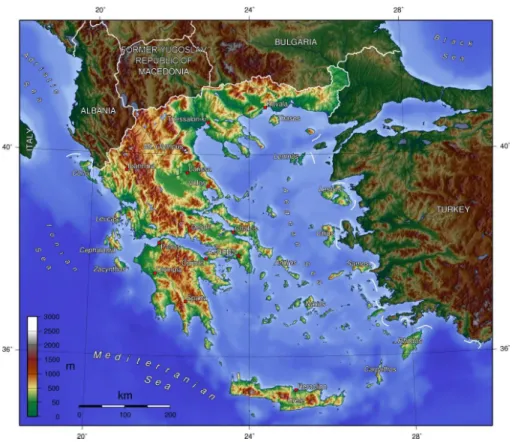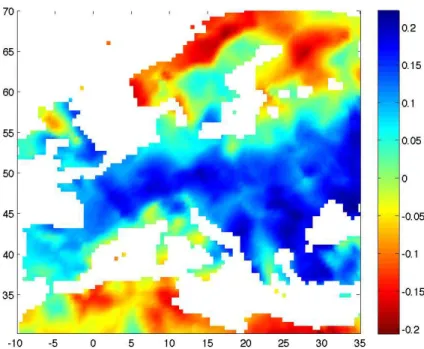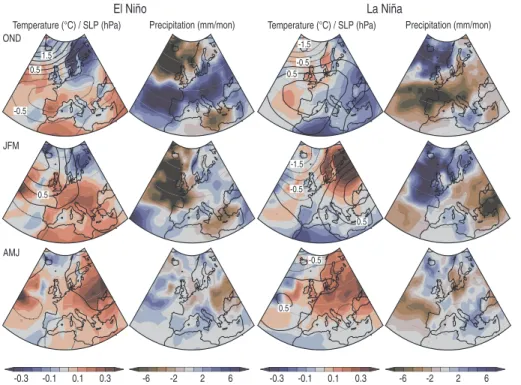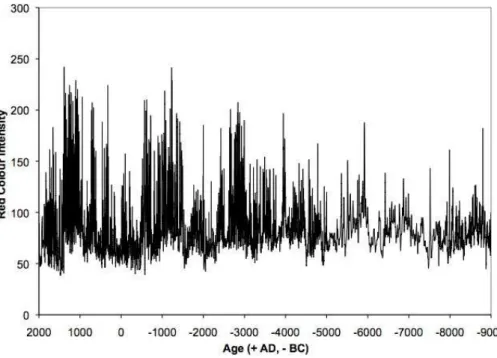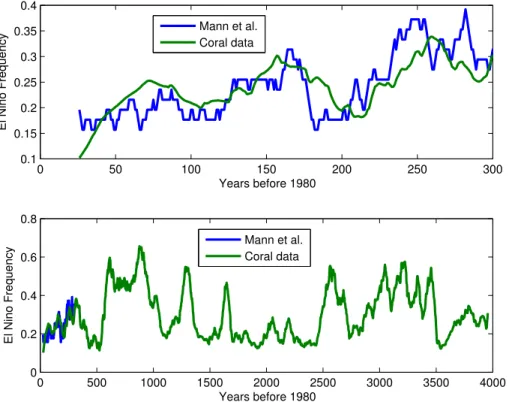CPD
6, 801–815, 2010Climate change and the demise of Minoan
civilization
A. A. Tsonis et al.
Title Page
Abstract Introduction
Conclusions References
Tables Figures
◭ ◮
◭ ◮
Back Close
Full Screen / Esc
Printer-friendly Version Interactive Discussion
Discussion
P
a
per
|
Dis
cussion
P
a
per
|
Discussion
P
a
per
|
Discussio
n
P
a
per
Clim. Past Discuss., 6, 801–815, 2010 www.clim-past-discuss.net/6/801/2010/ doi:10.5194/cpd-6-801-2010
© Author(s) 2010. CC Attribution 3.0 License.
Climate of the Past Discussions
This discussion paper is/has been under review for the journal Climate of the Past (CP). Please refer to the corresponding final paper in CP if available.
Climate change and the demise of Minoan
civilization
A. A. Tsonis1, K. L. Swanson1, G. Sugihara2, and P. A. Tsonis3
1
Department of Mathematical Sciences, Atmospheric Sciences Group, University of Wisconsin-Milwaukee, Milwaukee, WI 53201, USA
2
Scripps Institution of Oceanography, University of California San Diego, 9500 Gilman Drive, La Jolla, CA 92093-0202, USA
3
Department of Biology, University of Dayton, Dayton, OH 45469, USA
Received: 7 April 2010 – Accepted: 27 April 2010 – Published: 12 May 2010
Correspondence to: A. A. Tsonis (aatsonis@uwm.edu)
CPD
6, 801–815, 2010Climate change and the demise of Minoan
civilization
A. A. Tsonis et al.
Title Page
Abstract Introduction
Conclusions References
Tables Figures
◭ ◮
◭ ◮
Back Close
Full Screen / Esc
Printer-friendly Version Interactive Discussion
Discussion
P
a
per
|
Dis
cussion
P
a
per
|
Discussion
P
a
per
|
Discussio
n
P
a
per
Abstract
Climate change has been implicated in the success and downfall of several ancient civilizations. Here we present a synthesis of historical, climatic, and geological evi-dence that supports the hypothesis that climate change may have been responsible for the slow demise of Minoan civilization. Using proxy ENSO and precipitation recon-5
struction data in the period 1650–1980 we present empirical and quantitative evidence that El Ni ˜no causes drier conditions in the area of Crete. This result is supported by modern data analysis as well as by model simulations. Though not very strong, the ENSO-Mediterranean drying signal appears to be robust, and its overall effect was ac-centuated by a series of unusually strong and long-lasting El Ni ˜nos during the time of 10
the Minoan decline. We show that a change in the dynamics of the El Ni ˜no/Southern Oscillation (ENSO) system occurred around 3000 BC, which culminated in a series of strong and frequent El Ni ˜nos starting at about 1450 BC and lasting for several cen-turies. This stressful climatic tend, associated with the gradual demise of the Minoans, is argued to be an important force acting in the downfall of this classic and long-lived 15
civilization.
1 Introduction
The Minoan civilization was a prominent Bronze Age society which flourished from approximately 2700 to 1450 BC on Crete, Greece (Fig. 1). The Minoans developed splendid architecture, a complex language, and a written script that is still not under-20
stood. They built a significant naval power and coexisted with neighboring civilizations as the dominant influence in the region (apparently without being significantly threat-ened). Contact with Egypt and Mesopotamia influenced their culture, as the Minoan civilization evolved to become the forerunner of Greek civilization; thus Minoan so-ciety is generally regarded as the first European civilization. Following its regional 25
CPD
6, 801–815, 2010Climate change and the demise of Minoan
civilization
A. A. Tsonis et al.
Title Page
Abstract Introduction
Conclusions References
Tables Figures
◭ ◮
◭ ◮
Back Close
Full Screen / Esc
Printer-friendly Version Interactive Discussion
Discussion
P
a
per
|
Dis
cussion
P
a
per
|
Discussion
P
a
per
|
Discussio
n
P
a
per
disappeared around 1200 BC.
There are essentially two main theories that have been invoked to explain the demise of Minoan civilization, but neither matches the observed gradual decline that took place. One is the explosion of the volcano in Thera and the other is invasion and occupation by the Mycenaeans. The former was suggested by Marinatos (1939). This catastrophic 5
theory argues that earthquakes destroyed the palaces, tsunamis obliterated the fleet and peers of the Minoans, and the volcanic ash of Thera covered the whole island destroying crops and killing animals. This view was initially supported by geologists who agreed that the Thera eruption was of a colossal scale, and such effects were possible. However, in 1987 studies conducted at the Greenland ice cap dated frozen 10
ash from the Thera eruption and concluded that it occurred in 1645 BC (Hammer et al., 1987); a result which has been confirmed by subsequent studies (Friedrich et al., 2006; Manning et al., 2006) and placing the event several hundred years before the destruction of the Minoan palaces around 1450 BC and the final disappearance of Minoans around 1200 BC.
15
Minoan society faced many problems and physical disasters throughout its history but it rebounded to elevate its culture to high levels. So why did it not recover af-ter the destruction of 1450 BC? An explanation is provided by the hypothesis that an invasion by the Mycenaeans was responsible for the destruction of the palaces and their subsequent occupation contributed to the demise of Minoan civilization. How-20
ever, archeological evidence to support this idea is either contradictory or lacking. For example, skeletal remains consistent with an invasion pattern have never been found (Callender, 1999). Indeed in the palaces the dead were neatly buried in well preserved burial sites, a pattern inconsistent with an invasion scenario. The fact that the Myce-naeans did not establish themselves in nearby and more vulnerable Crete as they did in 25
CPD
6, 801–815, 2010Climate change and the demise of Minoan
civilization
A. A. Tsonis et al.
Title Page
Abstract Introduction
Conclusions References
Tables Figures
◭ ◮
◭ ◮
Back Close
Full Screen / Esc
Printer-friendly Version Interactive Discussion
Discussion
P
a
per
|
Dis
cussion
P
a
per
|
Discussion
P
a
per
|
Discussio
n
P
a
per
2 The climate connection
Climate has played a significant role in the disappearance of several cultures on Earth. A recent study (Sandweis et al., 2009), for example, reviews evidence of how envi-ronmental changes induced by earthquakes and El Ni ˜no flooding contributed to the demise of the early Supe settlements in Peru. Another example is the disappearance 5
of the Mayans. Around 800 AD, the Mayans were at the peak of civilization with a population of about 15 million occupying the area from Mexico’s Yucat ´an peninsula to Honduras, before they ultimately and rather suddenly disappeared. In addition to hy-potheses concerning epidemic disease as the agent, evidence has emerged that a long period of dry climate, punctuated by three intense droughts, may have contributed to 10
the end of Mayan society (Haug et al., 2003). Here we examine multiple and consistent evidence to suggest that climate played a central role in the downfall of Minoan civiliza-tion and that the ultimate mechanism was a fundamental change in the dynamics of El Ni ˜no/Southern Oscillation (ENSO).
ENSO is a phenomenon that takes place in the Pacific Ocean. During normal con-15
ditions the westward surface winds in the tropical Pacific sweep and accumulate over time warm surface water to the west. This leaves the surface eastern tropical Pacific with colder upwelling water. Thus during normal conditions (often referred as La Ni ˜na) there are cold surface temperatures in the eastern Pacific and warm in the western Pacific. The continual accumulation of warm water in the west increases the surface 20
elevation and eventually the warm pool of surface water sloshes back to cover all tropi-cal Pacific. We now have an El Ni ˜no, which is characterized by a large warm spot over the tropical Pacific Ocean. This surface warming is large enough to interact with the atmosphere, which is then modified and brings significant weather changes all over the world. These ENSO teleconnections are established via complex mechanisms in-25
CPD
6, 801–815, 2010Climate change and the demise of Minoan
civilization
A. A. Tsonis et al.
Title Page
Abstract Introduction
Conclusions References
Tables Figures
◭ ◮
◭ ◮
Back Close
Full Screen / Esc
Printer-friendly Version Interactive Discussion
Discussion
P
a
per
|
Dis
cussion
P
a
per
|
Discussion
P
a
per
|
Discussio
n
P
a
per
(Mokhov and Smirnov, 2006; Ineson and Scaife, 2009).
Figure 2 shows the correlation between the cold season (DJF) Nino3 index (Mann et al., 2000) and the seasonal (DJF) precipitation reconstruction over Europe (Pauling et al., 2006; Mitchell and Jones, 2005). The Nino3 data cover the period 1650–1980 AD and the gridded precipitation data the period 1500–2000 AD. The correlation is based 5
on the data in the period 1650–1980 AD. Most correlations are small but what is im-portant (especially with nonlinear interactions such as ENSO and precipitation telecon-nections) is emerging patterns. Here a very coherent and non-random spatial structure is evident suggesting a significant precipitation signal of El Ni ˜no over Europe. The map indicates drier conditions over Northern Africa and part of the Mediterranean (a direct 10
result of the cyclone track shifting northward during El Ni ˜no; Bronnimann, 2007), wetter conditions over most of Europe and drier conditions in Scandinavia. Even though it is only represented by two grid points, Crete is located in the drier belt. For the area of Crete we find that the fractional change of precipitation between El Ni ˜no and La Ni ˜na years to be around 10%. This result, as well as the correlation structure in Fig. 2, is 15
consistent with results using rainfall station data in the period 1880–1980 (Fraedrich and Muller, 1992; Bronnimann, 2007).
The El Ni ˜no signal on precipitation on Crete appears to be weak but as confirmed by modeling results it is a robust phenomenon and as we will see below during the time of the Minoans this signal may have been 2–3 times stronger. Figure 3 is based on model 20
simulations and also indicates that precipitation in the area of interest is reduced on the average during El Ni ˜no events and increased during La Ni ˜na events. Note that the El Ni ˜no OND and JFM maps are in very good agreement with the spatial structure in Fig. 2 and is reversed during La Ni ˜na years (from Bronnimann, 2007). This consistency suggests that the El Ni ˜no signal in the area of Crete is robust. Parenthetically we point 25
CPD
6, 801–815, 2010Climate change and the demise of Minoan
civilization
A. A. Tsonis et al.
Title Page
Abstract Introduction
Conclusions References
Tables Figures
◭ ◮
◭ ◮
Back Close
Full Screen / Esc
Printer-friendly Version Interactive Discussion
Discussion
P
a
per
|
Dis
cussion
P
a
per
|
Discussion
P
a
per
|
Discussio
n
P
a
per
same fate. This special case is reassuring however raises the question as to whether during the period from 1450 to 1200 BC El Ni ˜no activity was sufficiently unusual, broad and long-lasting to produce a strong enough signal to cause the gradual decline of the Minoans.
A recent study (Moy et al., 2002) documented the variability of El Ni ˜no/Southern 5
Oscillation activity at millennial timescales during the Holocene epoch (Fig. 4; adapted from Moy et al., 2002). This is a proxy record based on the distribution of inorganic clas-tic laminae in a core retrieved from Lake Laguna Pallcacocha in Ecuador. The laminae are deposited during ENSO-driven episodes of alluvial deposition in the Laguna Pallca-cocha drainage basin. These laminae are mixed with dark-colored organic-rich silt. The 10
surface of the core sections was scanned and the intensity of the red color was used to generate the proxy record. In general higher intensity values correspond to El Ni ˜no and lower values to La Ni ˜na. This record has been extensively analyzed and recent results (Moy et al., 2002; Tsonis, 2008) suggest a change in the dynamics at around 3000 BC. It appears that around that time a bifurcation occurred in the ENSO system causing 15
the attractor of the underlying dynamical system to become higher dimensional with less stable behavior (Tsonis, 2008). As a consequence the system switched from a dynamics where the normal La Ni ˜na condition was the dominant mode to a dynamics where El Ni ˜nos became more frequent and stronger. Changes in boreal summer in-solation or slow changes in ocean dynamics (which are known to be affected during 20
interglacial events) have been suggested as possible mechanisms for this bifurcation (Tsonis, 2008). This scenario is consistent with geoarchaeological evidence form Peru, which also suggests absence of El Ni ˜no before 5000 BP (3000 BC) and its onset after that (Sandweis et al., 1996). Additional support for the Ecuador ENSO proxy record is provided by a recent study of hurricane events (Donnelly and Woodruff, 2007). It is well 25
CPD
6, 801–815, 2010Climate change and the demise of Minoan
civilization
A. A. Tsonis et al.
Title Page
Abstract Introduction
Conclusions References
Tables Figures
◭ ◮
◭ ◮
Back Close
Full Screen / Esc
Printer-friendly Version Interactive Discussion
Discussion
P
a
per
|
Dis
cussion
P
a
per
|
Discussion
P
a
per
|
Discussio
n
P
a
per
sediment cores from Lake Ossa in West Cameroon (an area where ENSO’s effect on precipitation is well known) also correlates well with the Ecuador ENSO proxy record. According to Fig. 4, a series of intense El Ni ˜no events (high red color intensity) begins at about 1450 BC that will last for centuries. In that period normal (La Ni ˜na) conditions have but disappeared. For comparison, the very strong 1998 El Ni ˜no event scores 89 5
in red color intensity. During the time when the Minoans were fading, El Ni ˜no events reach values in red color intensity over 200. Figure 5 shows a comparison between the two proxies for ENSO used here. It shows El Ni ˜no frequency in a 50-year moving window. The top panel shows that the two proxies are in good agreement and the bot-tom panel that the El Ni ˜no events in the coral record (Fig. 4) starting at about 1450 BC 10
are much stronger than in the last three hundred years (by a factor between two and three). This will indicate that the El Ni ˜no signal may have been much stronger at the time of the Minoans. Thus, it is highly probable that the area of Crete experienced drier conditions from 1450 to 1200 BC and even later. For communities that strongly de-pended on water and agriculture in order to survive, the cumulative effect of these drier 15
conditions could have been devastating and may have led to a slow decline bringing the population below a critical threshold that will allow it to exist and thrive. The above results and observations are also supported by an O18analysis (Magill et al., 2005) of a core obtained from the Limnes depression, a small sinkhole located within the Akrotiri Peninsula, Crete (close to the palace of Knossos and other important outlets of the Mi-20
noans). This analysis indicates that wetter conditions during the middle Holocene were followed by drier conditions and that around 1450 BC a long stretch of drier conditions commenced ending around 1200 BC. Additional sediment support for drier conditions after 1450 BC is provided by a pollen core obtained from Lake Kournas in Crete. In that coreTilia(a temperate European tree) pollen, while present before 1400, has but 25
CPD
6, 801–815, 2010Climate change and the demise of Minoan
civilization
A. A. Tsonis et al.
Title Page
Abstract Introduction
Conclusions References
Tables Figures
◭ ◮
◭ ◮
Back Close
Full Screen / Esc
Printer-friendly Version Interactive Discussion
Discussion
P
a
per
|
Dis
cussion
P
a
per
|
Discussion
P
a
per
|
Discussio
n
P
a
per
3 Conclusions
We have presented a synthesis of historical, climatic, and geologic evidence which supports the hypothesis that climate change instigated by an intense El Ni ˜no activity contributed to the demise and eventual disappearance of the Minoan civilization The North Atlantic Oscillation (NAO) in its positive phase may also bring dry conditions in 5
the Mediterranean (Luterbacher and Xoplaki, 2003). This effect, however, cannot be assessed in the second millennium BC as no proxy NAO data extend that far. Never-theless, El Ni ˜no has been linked to NAO activity (Ineson and Scaife, 2009; Huang et al., 1998; Wang et al., 2009) and this possibility could have accentuated the dry conditions. Climate change and its associated effects will always influence our lives. While nobody 10
anymore expects any civilization to get extinct because of climate, it is becoming clear that convergent events such as earthquakes and volcanic activity in synergy with cli-mate anomalies may produce significant stress to contemporary populations vis-a-vis their social and economic development (Moseley, 1999). It is thus important that we understand how the evolutionary trajectory of early civilizations was disrupted and that 15
even today we may not be completely immune to hazardous stress induced by natural catastrophes.
Acknowledgements. We thank Elena Xoplaki for her suggestions.
References
Bronnimann, S.: Impact of El Nino-Southern oscillation on European climate, Rev. Geophys.,
20
45, RG3003, doi:10.1029/2006RG000199, 2007.
Callender, G.: The Minoans and the Mycenaeans: Aegean Society in the Bronze Age, Oxford University Press, UK, 1999.
Donnelly, J. P. and Woodruff, J. D.: Intense hurricane activity over the past 5000 years controlled by El Nino and the West African monsoon, Nature, 447, 465–468, doi:10.1038/nature05834,
25
CPD
6, 801–815, 2010Climate change and the demise of Minoan
civilization
A. A. Tsonis et al.
Title Page
Abstract Introduction
Conclusions References
Tables Figures
◭ ◮
◭ ◮
Back Close
Full Screen / Esc
Printer-friendly Version Interactive Discussion
Discussion
P
a
per
|
Dis
cussion
P
a
per
|
Discussion
P
a
per
|
Discussio
n
P
a
per
Fraedrich, K. and Muller, K.: Climate anomalies in Europe associated with ENSO extremes, Int. J. Climatol., 12, 25–31, 1992.
Friedrich, W. L., Kromer, B., Friedrich, M., et al.: Santorini eruption radiocarbon dated to 1627– 1600 BC, Science, 312, 548, 2006.
Hammer, C. U., Clausen, H. B., Friedrich, W. L., and Tauber, H.: The Minoan eruption of
5
Santorini in Greece dated to 1645 BC?, Nature, 328, 517–519, 1987.
Haug, G. H., Gunther, D., Peterson, L. C., et al.: Climate and the Collapse of Mayan Civilization, Science, 299, 1731–1735, 2003.
Huang, J.-P., Higushi, K., and Shabbar, A.: The relationship between The North Atlantic Oscil-lation and El Nino-Southern OscilOscil-lation, Geophys. Res. Lett., 25, 2701–2719, 1998.
10
Ineson, S. and Scaife, A. A.: The role of stratosphere in the European climate response to El Nino, Nature Geosci., 2, 32–36, 2009.
Luterbacher, J. and Xoplaki, E.: 500-year winter temperature and precipitation variability over the Mediterranean area and its connection to large-scale atmospheric circulation, in: Mediterranean Climate: Variability and Trends, edited by: Bolle, H., Springer, Berlin, 133–
15
153, 2003.
Magill, C. R., Rosenmeier, M. F., Cavallari, B. J., Curtis, J. H., and Weis, H.: Reconstruction of Holocene climate variability within the central Mediterranean using lake sediments from Akrotiri Peninsula, Crete, in: Abstract Volume of the Fall Meeting of the American Geophysi-cal Union, 5–9 December 2005, San Francisco, California, 2005.
20
Mann, M. E., Bradley, R. S., and Hughes, M. K.: Long-term variability in the El Nino southern oscillation and associated teleconnections, in: El Nino and the southern oscillation: multi-scale variability and its impacts on natural ecosystems and society, edited by: Diaz, H. F. and Markgraf, V., Cambridge University Press, 321–372, 2000.
Manning, S. W., Ramsey, C. B., Kutschera, W., et al.: Chronology for the Aegean late Bronze
25
age 1700–1400 BC, Science, 312, 565–569, 2006.
Marinatos, S.: The Volcanic Destruction of Minoan Crete, Antiquity, 13, 425–439, 1939. Mitchell, T. D. and Jones, P. D.: An improved method of constructing a database of monthly
climate observations and associated high-resolution grids, Int. J. Climatol., 25, 693–712, 2005.
30
CPD
6, 801–815, 2010Climate change and the demise of Minoan
civilization
A. A. Tsonis et al.
Title Page
Abstract Introduction
Conclusions References
Tables Figures
◭ ◮
◭ ◮
Back Close
Full Screen / Esc
Printer-friendly Version Interactive Discussion
Discussion
P
a
per
|
Dis
cussion
P
a
per
|
Discussion
P
a
per
|
Discussio
n
P
a
per
Moseley, M. E.: Convergent catastrophe: Past patterns and future implications of collateral natural disasters in the Andes, in: The Angry Earth, edited by: Oliver-Smith, A. and Hoffman, S. M., Routledge, New York, 59–71, 1999.
Moy, C. M., Seltzer, G. O., Rodbell, D. T., and Anderson, D. M.: Variability of El Nino/Southern Oscillation activity at millennial timescales during the Holocene epoch, Nature, 420, 162–
5
165, 2002.
Pauling, A., Luterbacher, J., Casty, C., and Wanner, H.: Five hundred years of gridded high-resolution precipitation reconstructions over Europe and the connection to large-scale circu-lation, Clim. Dynam., 26, 387–405, 2006.
Sandweiss, D. H., Richardson, J. B., Reitz, E. J., et al.: Geoerchaeological evidence from Peru
10
for a 5000 years BP onset of El Nino, Science, 273, 1531–1533, 1996.
Sandweis, D. H., Solis, R. S., Moseley, M. E., Keefer, D. K., and Ortloff, C. R.: Environmental change and economic development in coastal Peru between 5,800 and 3,600 years ago, Proc. Natl. Acad. Sci. USA, 106, 1359–1363, doi/10.1073/pnas.0812645106, 2009.
Tsonis, A. A.: Dynamical changes in the ENSO system in the last 11000 years, Clim. Dynam.,
15
33, 1069–1074, doi:10.1007/s00382-008-0469-4, 2008.
CPD
6, 801–815, 2010Climate change and the demise of Minoan
civilization
A. A. Tsonis et al.
Title Page
Abstract Introduction
Conclusions References
Tables Figures
◭ ◮
◭ ◮
Back Close
Full Screen / Esc
Printer-friendly Version Interactive Discussion
Discussion
P
a
per
|
Dis
cussion
P
a
per
|
Discussion
P
a
per
|
Discussio
n
P
a
per
CPD
6, 801–815, 2010Climate change and the demise of Minoan
civilization
A. A. Tsonis et al.
Title Page
Abstract Introduction
Conclusions References
Tables Figures
◭ ◮
◭ ◮
Back Close
Full Screen / Esc
Printer-friendly Version Interactive Discussion
Discussion
P
a
per
|
Dis
cussion
P
a
per
|
Discussion
P
a
per
|
Discussio
n
P
a
per
CPD
6, 801–815, 2010Climate change and the demise of Minoan
civilization
A. A. Tsonis et al.
Title Page
Abstract Introduction
Conclusions References
Tables Figures
◭ ◮
◭ ◮
Back Close
Full Screen / Esc
Printer-friendly Version Interactive Discussion
Discussion
P
a
per
|
Dis
cussion
P
a
per
|
Discussion
P
a
per
|
Discussio
n
P
a
per
0.5 1.5
-0.5
0.5
0.5 -0.5 -1.5
0.5 -0.5
OND
JFM
AMJ
El Niño La Niña
-6 -2 2 -6 -2 2
-0.3 -0.1 0.1 0.3 6 -0.3 -0.1 0.1 0.3 6
0.5 -0.5
-1.5
Temperature (°C) / SLP (hPa) Precipitation (mm/mon) Temperature (°C) / SLP (hPa) Precipitation (mm/mon)
CPD
6, 801–815, 2010Climate change and the demise of Minoan
civilization
A. A. Tsonis et al.
Title Page
Abstract Introduction
Conclusions References
Tables Figures
◭ ◮
◭ ◮
Back Close
Full Screen / Esc
Printer-friendly Version Interactive Discussion
Discussion
P
a
per
|
Dis
cussion
P
a
per
|
Discussion
P
a
per
|
Discussio
n
P
a
per
CPD
6, 801–815, 2010Climate change and the demise of Minoan
civilization
A. A. Tsonis et al.
Title Page
Abstract Introduction
Conclusions References
Tables Figures
◭ ◮
◭ ◮
Back Close
Full Screen / Esc
Printer-friendly Version Interactive Discussion
Discussion
P
a
per
|
Dis
cussion
P
a
per
|
Discussion
P
a
per
|
Discussio
n
P
a
per
0 50 100 150 200 250 300
0.1 0.15 0.2 0.25 0.3 0.35 0.4
Years before 1980
El Nino Frequency
Mann et al. Coral data
0 500 1000 1500 2000 2500 3000 3500 4000
0 0.2 0.4 0.6 0.8
Years before 1980
El Nino Frequency
Mann et al. Coral data
